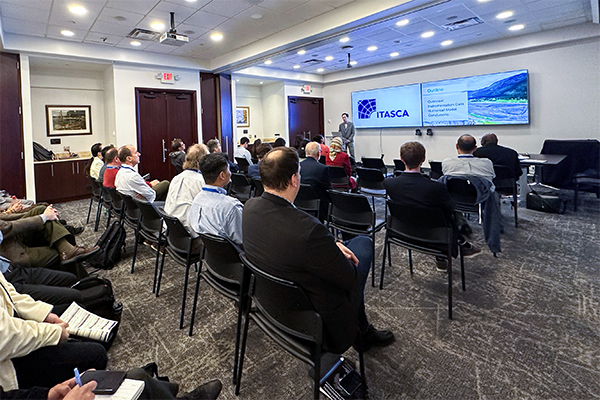

Mark Bancroft of Knight Piésold Canada Presents Tailings Dam Creep Modelling at ITASCA Symposium
June 11, 2024, Vancouver, BC, Canada – Mark Bancroft, a project engineer at Knight Piésold Canada, presented modelling work of creep behaviour observed under a tailings dam at the 6th International ITASCA Symposium on Applied Numerical Modeling in Geomechanics, held on June 3–6, 2024, in Toronto, Canada.
The symposium brought together professionals in the civil, energy, materials, and mining industries, presenting their findings on applied numerical analysis and research using ITASCA’s suite of modelling software.
Sixty papers illustrating a wide range of numerical approaches to solve geotechnical and geomechanical problems were selected for presentation, including mining, underground construction, slope stability, dams, nuclear waste disposal, masonry structures, and other special topics.
Bancroft presented the paper titled, “Estimating shear stress within a clay foundation using the Burgers-creep model,” which was co-authored by Salina Yong, a specialist geomechanical engineer at Knight Piésold Canada, during the session on coupled and time-dependent processes.
Slope inclinometers that were installed along the embankment of an operating tailings storage facility (TSF) showed constant-rate creep deformations within the medium plastic clay foundation under the TSF. A FLAC model was constructed to estimate shear stress distribution within the clay to later assist with estimating the potential for creep rupture. The clay was modelled using the Burgers-creep viscoplastic constitutive model as it can be calibrated against slope inclinometer data to capture the observed deformations.
“The Burgers-creep viscoplastic model can be a simple, practical constitutive model for analyzing the creep phenomenon,” said Bancroft. “The constitutive model can be calibrated to readily available displacement data from inclinometers that are often installed as part of requisite dam safety monitoring programs, as opposed to requiring advanced laboratory testing that requires good quality undisturbed sampling.”
Yong added, “The modelling results are being used to evaluate the potential for creep rupture—crucial to our ongoing monitoring of the TSF and also useful for future closure planning.”
“With a comprehensive understanding of project specific site conditions, our team analyzes influential factors to inform designs for and the implementation of facility operations, expansions, and closure, in addition to performance monitoring. We continue to support our clients in promoting responsible and safe infrastructure management.”